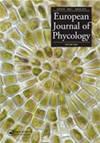Galactolipids of the genus Amphidinium (Dinophyceae): an hypothesis that they are basal to those of other peridinin-containing dinoflagellates
IF 1.7
4区 生物学
Q2 MARINE & FRESHWATER BIOLOGY
引用次数: 3
Abstract
ABSTRACT The genus Amphidinium is shown in many phylogenies to be basal to other peridinin-containing, photosynthetic dinoflagellates as one of the first photosynthetic genera to arise after the evolution of heterotrophic genera. As part of our continuing examination of the plastid-associated galactolipids, namely mono- and digalactosyldiacylglycerol (MGDG and DGDG, respectively), in dinoflagellates, we here examine the galactolipid composition of members of the genus Amphidinium. We show that this genus is characterized by an abundance of 20:5(n-3)/18:5(n-3) and 20:5(n-3)/18:4(n-3) forms of MGDG and DGDG (with sn-1/sn-2 regiochemical specificity of fatty acids), but also sometimes with generally lesser amounts of some polyunsaturated C18/C18 forms, thus placing the examined species within a previously identified cluster of C20/C18 MGDG- and DGDG-containing, peridinin-containing dinoflagellates. We also show that Testudodinium testudo, previously known as Amphidinium testudo, conversely falls within a previously identified C18/C18 cluster, indicating a distinct difference in galactolipid biosynthesis capability. While it is likely that further revision of the genus may occur in the future and/or more basal peridinin-containing, photosynthetic genera may be discovered, at the current time Amphidinium is the currently agreed-upon most basal dinoflagellate genus for which isolates are available for biochemical characterization such as what we describe in this paper. Thus, because of the presumed basal position of the genus Amphidinium, we present a hypothesis that its galactolipids currently represent those that are ancestral to other genera of peridinin-containing dinoflagellates, including those within the C18/C18 cluster. Highlights Amphidinium species’ galactolipids reside within the C20/C18 peridinin dinoflagellate cluster. Conversely, Testudodinium testudo (formerly Amphidinium testudo) falls within the C18/C18 cluster. We hypothesize Amphidinium’s galactolipids as basal to other peridinin dinoflagellates.甲藻属(甲藻科)的半乳脂:一种假设认为它们是其他含甲藻的甲藻的基础
摘要:在许多系统发育中,双鞭毛属是异养属进化后最早出现的光合作用属之一,是其他含水蛭素的光合鞭毛藻的基础。作为我们对鞭毛藻中与质体相关的半乳糖脂,即单半乳糖和双半乳糖二酰基甘油(分别为MGDG和DGDG)的持续研究的一部分,我们在这里研究了双鞭毛藻属成员的半乳糖脂组成。我们发现该属的特点是MGDG和DGDG的丰度为20:5(n-3)/18:5(n-3)和20:5(n-3)/18:4(n-3)形式(具有sn-1/sn-2脂肪酸的区域化学特异性),但有时也含有一些通常较少数量的多不饱和C18/C18形式,因此将所研究的物种置于先前鉴定的C20/C18 MGDG和DGDG的集群中。我们还表明,Testudodinium testdo,以前被称为Amphidinium testdo,相反地属于以前鉴定的C18/C18簇,表明半乳糖脂生物合成能力有明显差异。虽然将来可能会对该属进行进一步的修订,并且/或可能会发现更多含有佩啶的基础光合属,但目前Amphidinium是目前公认的最基础的鞭毛属,其分离物可用于生化表征,例如我们在本文中描述的。因此,由于推测其属的基础位置,我们提出了一种假设,即其半乳糖脂目前代表了其他含有橄榄苷的甲藻属的祖先,包括那些在C18/C18集群中的甲藻。两栖类的半乳糖脂位于C20/C18环甲鞭毛虫群中。相反,Testudodinium testudo(以前的Amphidinium testudo)属于C18/C18星团。我们假设甲藻的半乳糖脂是其他甲藻的基础。
本文章由计算机程序翻译,如有差异,请以英文原文为准。
求助全文
约1分钟内获得全文
求助全文
来源期刊

European Journal of Phycology
生物-海洋与淡水生物学
CiteScore
4.80
自引率
4.20%
发文量
37
审稿时长
>12 weeks
期刊介绍:
The European Journal of Phycology is an important focus for the activities of algal researchers all over the world. The Editors-in-Chief are assisted by an international team of Associate Editors who are experts in the following fields: macroalgal ecology, microalgal ecology, physiology and biochemistry, cell biology, molecular biology, macroalgal and microalgal systematics, applied phycology and biotechnology. The European Journal of Phycology publishes papers on all aspects of algae, including cyanobacteria. Articles may be in the form of primary research papers and reviews of topical subjects.
The journal publishes high quality research and is well cited, with a consistently good Impact Factor.
 求助内容:
求助内容: 应助结果提醒方式:
应助结果提醒方式:


